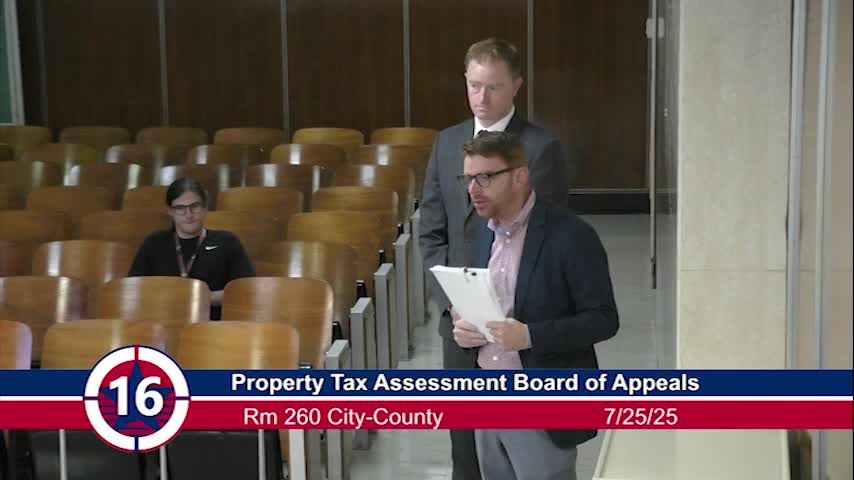Indianapolis Approves $1.36M Tax Exemption For Affordable Housing Project Funding
July 25, 2025 | Indianapolis City, Marion County, Indiana
This article was created by AI summarizing key points discussed. AI makes mistakes, so for full details and context, please refer to the video of the full meeting. Please report any errors so we can fix them. Report an error »

In a recent meeting of the Property Tax Assessment Board of Appeals in Indianapolis, discussions centered around a significant low-income housing project that has garnered attention due to its financial structure and community impact. The project, which is financed through Section 42 low-income housing tax credits, aims to provide affordable housing options in a city facing increasing housing demands.
The developers, represented by Corey Stark of Virgin Health Asset Management, outlined the project's commitment to offering 216 units of affordable housing, with rents capped to ensure accessibility for low-income residents. The average rent for a two-bedroom unit is set at approximately $1,100, significantly lower than the market rate of around $1,800 to $1,900. This pricing structure is designed to accommodate families earning less than 60% of the area median income, which translates to an annual income of about $60,000 for a four-person household.
A key aspect of the project is its Payment in Lieu of Taxes (PILOT) agreement with the city, which allows the developers to pay a fixed amount instead of traditional property taxes. This financial arrangement is crucial for the project's viability, as it enables the developers to meet their debt obligations and maintain affordable rent levels. Stark emphasized that without this incentive, the project would not be financially sustainable.
The meeting also highlighted the additional services provided to residents, including financial literacy programs and community events aimed at fostering a sense of belonging. These initiatives are part of the developers' commitment to enhancing the quality of life for residents, beyond just providing housing.
However, the discussions were not without concern. Board members expressed surprise at the rental rates, questioning how $1,100 for a two-bedroom unit could be classified as low income. This sentiment reflects broader concerns about housing affordability in Indianapolis, where many residents struggle to find suitable living conditions within their financial means.
As the board deliberates on the exemption request for 2024, the implications of this project extend beyond mere numbers. It represents a critical effort to address the housing crisis in Indianapolis, providing much-needed affordable options while also raising questions about the sustainability of such initiatives in the face of rising living costs. The outcome of this meeting could set a precedent for future low-income housing projects in the city, highlighting the ongoing challenge of balancing development with affordability.
The developers, represented by Corey Stark of Virgin Health Asset Management, outlined the project's commitment to offering 216 units of affordable housing, with rents capped to ensure accessibility for low-income residents. The average rent for a two-bedroom unit is set at approximately $1,100, significantly lower than the market rate of around $1,800 to $1,900. This pricing structure is designed to accommodate families earning less than 60% of the area median income, which translates to an annual income of about $60,000 for a four-person household.
A key aspect of the project is its Payment in Lieu of Taxes (PILOT) agreement with the city, which allows the developers to pay a fixed amount instead of traditional property taxes. This financial arrangement is crucial for the project's viability, as it enables the developers to meet their debt obligations and maintain affordable rent levels. Stark emphasized that without this incentive, the project would not be financially sustainable.
The meeting also highlighted the additional services provided to residents, including financial literacy programs and community events aimed at fostering a sense of belonging. These initiatives are part of the developers' commitment to enhancing the quality of life for residents, beyond just providing housing.
However, the discussions were not without concern. Board members expressed surprise at the rental rates, questioning how $1,100 for a two-bedroom unit could be classified as low income. This sentiment reflects broader concerns about housing affordability in Indianapolis, where many residents struggle to find suitable living conditions within their financial means.
As the board deliberates on the exemption request for 2024, the implications of this project extend beyond mere numbers. It represents a critical effort to address the housing crisis in Indianapolis, providing much-needed affordable options while also raising questions about the sustainability of such initiatives in the face of rising living costs. The outcome of this meeting could set a precedent for future low-income housing projects in the city, highlighting the ongoing challenge of balancing development with affordability.
View full meeting
This article is based on a recent meeting—watch the full video and explore the complete transcript for deeper insights into the discussion.
View full meeting
